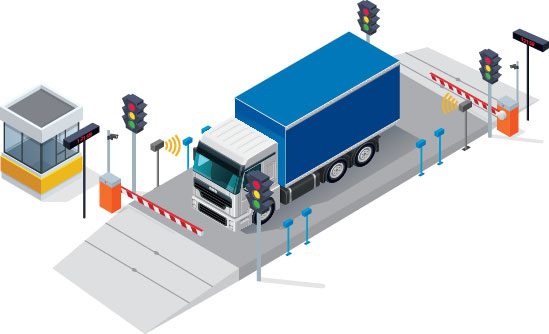If your business involves the frequent transfer of goods between different places, you can use a weighbridge to streamline the operations. Weighbridges or truck scales are used in varied industries to measure the loaded vehicles in transit. The industries depend on the precision of the weighbridges for the prevention of accidents and errors. It is used diversely in the logistics and transportation industry, construction sites, agriculture, and many more. Weighbridges also help organizations adhere to the standard protocols to avoid any hefty penalty for overloading trucks.
Weighbridge truck scales are equipped with load cells or mechanical weighing instruments. Weighbridges are installed in areas with enough space to safely and efficiently allow the trucks to enter the weighing platform. The main components include its foundation, platform (which acts as the driving surface), strain gauge load cells, terminal, and cables. The steel platform of the weighbridge is mounted on load cells.
The load cells are made of durable material (steel/concrete) and are attached to one or more strain gauges. Strain gauges consist of a wire that transmits the electric current generated when the load cells alter under stress. The analog signal is sent to the junction box, which combines the multiple signals. It is transferred to the weighbridge controller, which digitizes the signal and registers the load’s weight on the LED screen.
You can easily?find weighbridge manufacturers in India?on any search engine. You can also ask your supplier to provide you with powerful and?cost-effective software?to support the weighbridge’s operation. The right supplier will give you a high-performance weighbridge, interfaces, software, and other peripherals to meet your weighing and operational needs.?
Weighbridges identify the onboard goods’ weight by subtracting the vehicle’s net weight from the gross weight. Innovative, accurate, and reliable weighbridges can be used in the industrial sector to track inventory in and out of their facility and gain valuable insight into the raw material’s usage. Besides inventory tracking, weighbridges are used to check the legal weight limit of the trucks.
Since a weighbridge is a?long-term investment, a proper maintenance strategy must keep the weighbridge system functional and minimize downtime. It can improve the efficiency of your business by providing accurate results only if it is adequately maintained. Here are a few pointers that will help you figure out how to clean and maintain your weighbridge to achieve consistent and precise weight measurement.?
Daily Inspection
? Pit Mounted Weighbridge: Inspect the pit visually to identify if the cavity is not affecting the weighbridge’s performance. Check if any build-ups of mud and dirt might be hindering its operations.
? Surface-Mounted Weighbridge: Observe the weighbridge’s surroundings to check if any unwanted material is potentially obstructing its performance. In a surface-mounted weighbridge, sufficient space is required between the weighbridge superstructure and the ground. The load cells of this weighbridge should be checked to see if anything is impairing its operation.
? Rubber T Section: Some weighbridges include a ‘T’ shaped rubber inserted between the central platform and the surface around it. It helps to prevent any contaminants from entering the pits. The rubber section needs to be cleaned regularly.
Weekly Routines
? Weighing Checks: Weekly checks ensure no glitch in the weighbridge’s mechanical performance. You can conduct it yourself by recording the measurement when a vehicle is placed on one end of the weighing platform. You need to repeat the same step when the vehicle is placed in the platform’s middle and end. Collate the data to analyze the readings. If there is any significant discrepancy in the three readings, you need to repair your weighbridge.
Monthly Routines
For monthly follow-ups on the performance of the weighbridge, you can do the following:
? Measure the platform to check if the platform’s positioning has altered since the last calibration test.
? Use a jet washer to clean the platform thoroughly. Clean the underside area carefully without hitting the load cells. You can contact a specialist to avoid water ingression.
? ‘Zero’ the weighbridge and conduct an end-middle-end test, as discussed above.
Calibration Testing Methods
? Zero calibration testing: The empty weighbridge is calibrated to zero.
? Range Test: Calibrate the weighbridge to its maximum known weight.
? Repeatability Test: Conduct this test to ensure that the weighbridge displays the same result every time, depending on the calibrated load position.
? Load Cell Eccentricity Text: Test the load cells to check if the different load cells produce unequal output.
? Linearity Test: Test the weighbridge capacity as per the standard test weight protocols.
To Conclude:
To ensure that the weighbridge is giving a consistent performance without any error, you need to conduct various on-site calibration tests. Simple routine checks ensure that the machinery provides improved accuracy, better reliability so that it requires fewer engineer call-outs.

As the editor of the blog, She curate insightful content that sparks curiosity and fosters learning. With a passion for storytelling and a keen eye for detail, she strive to bring diverse perspectives and engaging narratives to readers, ensuring every piece informs, inspires, and enriches.










